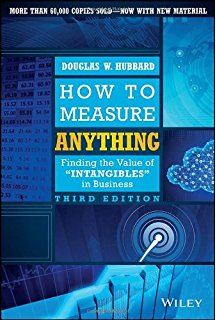Fractured Atlas Book Club: How to Measure Anything
Back in September, we looked at some of the key principles of Ciara Pressler’s Game Plan. Pressler suggested that a good game plan must be measurable, because “if you can’t track it, you won’t hack it.” But what does it mean to have a measurable game plan?

According to Douglas R. Hubbard’s How to Measure Anything, asking yourself both what you are measuring and why is key to actually finding some new information that will be useful for you. For example, I could spend a lot of time examining data on traffic to my artist website, but if I actually don’t have some purpose I’m trying to achieve by getting people on my website in the first place, that information isn’t all that valuable to me. If I’m trying to attract people to come to my monthly reading series, there are probably many ways I can begin to invest in measuring attendance over time. Depending on my goal, different measures matter more or less to me. For instance, am I really interested in just getting more bodies in the room? If my goal is to get writers in my networks to attend and get them interested to participate as readers in the series, I will probably want to focus my energy on measuring how other writers engage with me online, and how often and when writers seem to be motivated to attend the series. That should help me come up with a plan for how I can get more writers to sign up for updates about the monthly series through my website.
As an artist myself, I know firsthand that it’s a self-enforcing stereotype that artists aren’t particularly known for their quantitative skills. It might feel daunting to return to college-level statistics, or even to dive into statistics for the first time. Luckily, Hubbard shows how you can find more information in relatively painless ways, rather than grading you on your mathematical ability. He suggests that people often object to measuring “intangibles” because they believe measurement is prohibitively expensive, intimidatingly difficult, or time-consuming.
Beyond the fact that measurement can feel like a formidable task, Hubbard also observes that people feel that to measure certain things would be morally or ethically problematic, such as quantifying the economic value of human life or culture. Artists and arts organizations have considerable reasons to be skeptical of quantitative metrics, because “numbers” are often used by politicians and other public officials to justify defunding the arts during budget cuts, because their perceived utility is judged to be less impactful or essential than other sectors of the economy. To each of us, the arts are definitively invaluable and undervalued. That said, if other industries are much better at quantifying their own value, what would it mean for artists to take hold of measurement tools to communicate the value of their work? This is especially important when seeking funding through grants, as grantors will often ask for evidence of measurable results of how funds enabled the success of your work in final reports. Grantors may ask for information like demographic data on your audiences, how many people attended your events, and how much you received in contributions from individual donors to support your work.
Some advocacy and research groups are using quantitative information to empower artists and arts organizations, rather than mount evidence against the value of the arts. For example, W.A.G.E. (Working Artists and the Greater Economy) used surveys of artists and information about institutional budgets to calculate fair compensation for artists working with museums, arts non-profits, and other institutions. Clearly artists can seize the means of measurement to accomplish our own goals and demystify some parts of the numbers game. As an organization, Fractured Atlas is also committed to data-driven decision-making. We require that our fiscally sponsored projects submit annual reports that help us measure the impact that fiscally sponsored artists and arts organizations make in their communities. From an advocacy standpoint, this information can be extremely valuable to show funders and local and state governments the value of arts to local and regional communities.
So what measurement tools might empower you in your own work? One of the simplest strategies you might use is to remember Hubbard’s “Rule of Five” which states that “there is a 93.75% chance that the median of a population is between the smallest and largest values in any random sample of five from that population.” You might be thinking that you can’t be sure of anything by only asking five people. While it’s true that you can’t be 100% certain of anything without expending a tremendous amount of time and energy to survey as large a sample size as possible, you can reduce your uncertainty rather efficiently if you gain insight from five people. For example, if five random people in my networks tell me how much they give to crowdfunding campaigns on average, I should have a fairly good idea of the range of amounts people will be willing to give to my upcoming campaign.
Beware, however, of bias in your sample, especially if those people are your friends. They might know why you’re asking and want to act as if they are or will be more generous than they really are. That’s why it’s essential that any sample actually be chosen at random (and Hubbard explains what random actually means in practice) and to reduce other opportunities for bias wherever possible. So if you have access to data about how people actually behaved, such as how many of your newsletter subscribers came to your performance last year, a sample of that information might more reliably indicate how many will show up this year. If you’re trying to fill more seats this year, you can also take a look to see what other information you already have at your disposal. During what month was your most well-attended event? How much did tickets to your most well-attended event cost? How many people wrote to you and said they couldn’t attend because the event’s start-time overlapped with the end of the work day? Looking at all this information can help you make more informed decisions for your next show. (P.S. This example should also serve as compelling confirmation as to why you should use CRM software, like Artful.ly, to track your fans.)
So when you try to measure “anything”, your objective isn’t truly to be able to measure everything. Your goal is to measure that one thing that will actually be useful and serve your purpose. And the task of measurement doesn’t mean you’ll be 100% certain of an outcome. Measurement should help you become more informed so that you can make decisions that are less arbitrary and more confident that you’ll be successful in the business side of your work.
Have you encountered any excellent books that helped you achieve success? No reason to keep secrets among friends! Please email, tweet, or Facebook us with the details so that we can share it on our blog.
About Arno Mokros
Arno Mokros is a queer writer, print artist, and administrative professional committed to fostering accessibility and inclusion in arts communities. He is co-founding editor of Little Pharma, an intersectional feminist art and literary zine, a dedicated space for creative explorations of mental illness. Prior to joining the Fractured Atlas team, he gained program administration experience at the Social Science Research Council in Brooklyn, NY. He holds a B.A. from Smith College, and completed coursework at the University of Hamburg in Hamburg, Germany.


